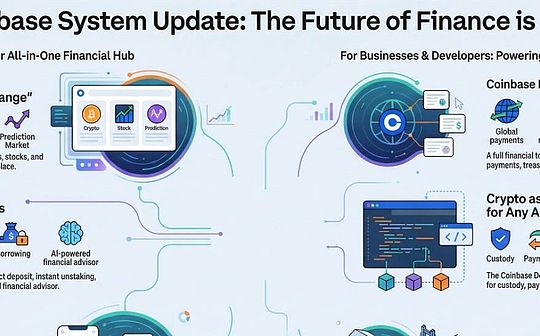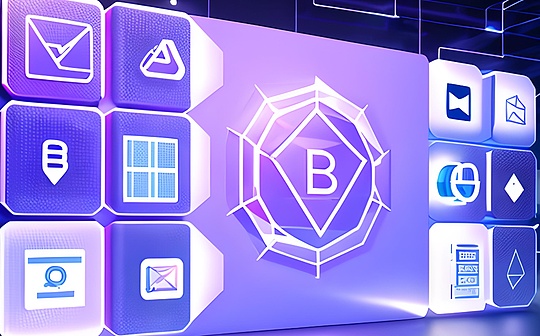
Author: TANAY VED & Amp; Matías Andrade Source: Coin Metrics Translation: Good Oba, Bit Chain Vision Realm
Key points:
-
The 1st -level currency soared in early 2024, but since then, it has lost motivation. The return rate of most online native currencies has fallen below 50% since the beginning of the year.
-
The decline in chain and market activities has led to a decline in the total cost of major Layer-1, including Ethereum ($ 1.15 million), Solana ($ 724,000) and Bitcoin ($ 463,000) (US $ 463,000)
-
High -throughput networks like Solana show unique trading models. Compared with Bitcoin and Ethereum, they are characterized by more frequent transactions and lower value.
introduce
In recent years, the pattern of Layer-1 blockchain has changed significantly.The networks such as Bitcoin, Ethereum and Solana constitute a pillar of the cryptocurrency ecosystem. Each network provides unique scalability, security and decentralized methods.As the demand for blockchain -based applications continues to increase, the L1 network is constantly adapted to the challenges of increasing transaction volume, energy efficiency and interoperability increases.The competition between these networks has promoted the rapid progress of technology. From Ethereum transitions from Merge to the proof of equity, to Solana’s attention to high -speed transactions, and then to Avalanche’s custom subnet architecture.
Coin Metrics this weekIn the network status reportWe thoroughly studied the 1st network and compared their performance, trading characteristics and cost markets.
L1 token performance
In early 2024, the Layer-1 field representing the underlying blockchain network has attracted widespread attention.After the FTX collapse, with the rapid growth of the market and the rapid growth of Solana, people’s attention seemed to turn to a substitution Layer-1, and their different methods gradually became the focus.Specifically, discussions around integrated networks such as Solana and Ethereum, replacement of virtual machines and high -performance blockchain such as virtual machines and Aptos and SUI have become prominent topics.
>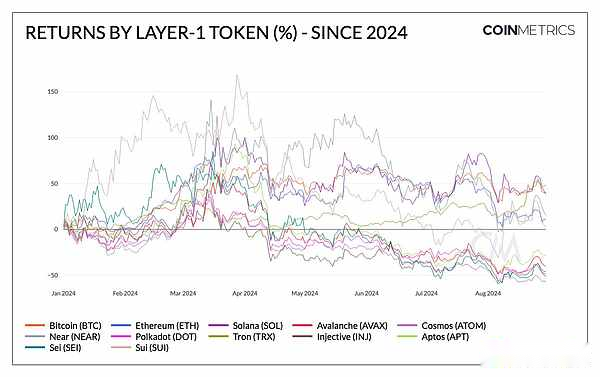
Source: coin metrics reference interest rate
The above figure shows this, and the return rate of the first -level token has reached its peak in March to the present.Despite this synergy effect, there are still some decentralized fields between these tokens. The integrated high throughput networks such as Solana, SUI, SEI, and Aptos lead the rise with Near.EssenceWith the integration of the market, some of these tokens have entered a negative area, but other tokens such as Solana, TRON, Ethereum, NEAR and SUI have maintained a positive value at the beginning of the year.
Market emotions and architecture weighing may continue to affect the perceived value of L1 native currency, but in the long run, considering the basic indicators of use and value is important. These indicators may originate from them similar to the nature of emerging market currencies and similar products.The characteristics of the characteristics of cash flow -like shares are characterized.
Focus on the expense market
As a provider of limited block space, the first floor of the blockchain and its verification (in POS) or miners (in POW) will pay for the transaction fee paid by users who want to include them in the network.Although the cost mechanism may be different in each L1, they are the source of incentives for network participants and the source of income from the 1st layer of networks. Usually, the native currency of the network (that is, BTC, ETH, SOL) payments.
>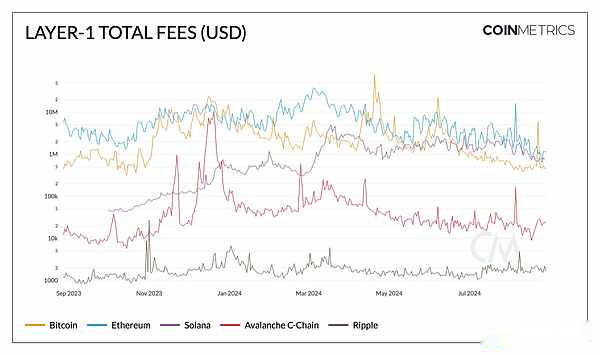
Source: Coin Metrics Network Data Pro
As shown in the figure above, the total expenses of each L1 change according to the requirements of block space. Market events and cost structures will affect this change.For example, Ethereum has always maintained the highest total cost, with an average of about 4-5 million US dollars under normal market conditions, and occasionally peaks occasionally at the peak of network activities.This performed very clearly in March. At that time, the total cost reached 38 million US dollars, and on August 5th,,The chain activity around the yen arbitrage transaction pushed the cost to $ 16 million.
Compared with historical data, the total cost on Ethereum has decreased. Although the average transaction cost of Solana is low, it has succeeded through supporting low -value transactions at higher frequency -although it has recently declined.On Bitcoin, specific events of the network, such as BitcoinFourth timeHalf, the launch of Runes and the recent introduction of Bitcoin pledge have led to the percentage of transaction costs that accounted for miners’ income (%) cycle.
It is also important to consider the destruction and distribution mechanism adopted by L1, which directly affects the dynamics of the supply of native currencies -affecting the holder/pledker through scarcity or pledge rewards.
Ethereum -ultrasonic currency and accessibility
As Ethereum continues to develop through Rollup as the center, the introduction of BLOB’s EIP-4844 reduces L2 transaction costs to a minimum USD, making it easier to access its second-level ecosystem.However, in the short term, this can be said to be at the cost of sacrificing the total expenses incurred by the main network (L1).As a result, this hinders ETH’s destruction speed to a minimum of 80 ETH or 194,000 US dollars.This is the dual nature of “super -stable currency”. It creates a tightening pressure for ETH, and at the same time, Ethereum is friendly to everyone, and also surge ETH on its second floor (L2).
>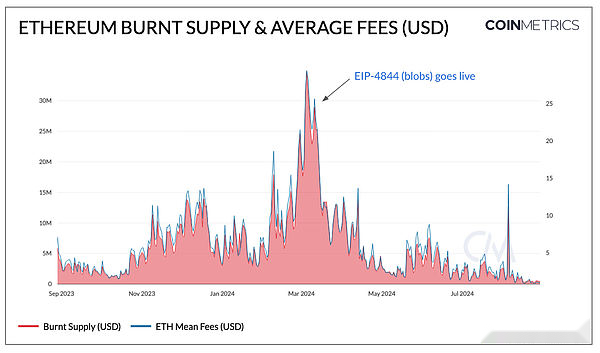
Source: Coin Metrics Network Data Pro
The total cost on Ethereum includesBasic cost(Dynamic changes according to demand and destroy from circulation),Priority(“Tips” are used to motivate authenticants to deal with transactions priority) and BLOB costs (paid by L2 by settlement transactions using BLOB on L1).However, due to the significant decline in L2 settlement costs, BLOB costs are currently insignificant to contributing to L1 costs, so the impact of reducing the amount of destruction and inflation pressure on ETH supply has affected the holder (inactive).Nevertheless, due to the progress and accessibility of L2, Ethereum is still expected to benefit from the surge in the event.
Solana -Preferred consideration or not preferred consideration
Solana’s cost mechanism structure is different, itfixedBasic costIt is a signature of 5000 LAMPOR (0.000005 SOL, the smallest unit of SOL).Whether it is casting a new Memecoin or a token transfer on DEX, users on Solana pay the same basic costs.This is different from Ethereum, and the basic expenses of Ethereum will be dynamically adjusted according to network demand.On the other hand, priority costs are optional fees that users can pay to increase the possibility of being included in the transaction by chief verification. 50% of which are burned and 50% are owned by verifications.However, due to the fluctuation of demand, the best priority cost may be challenging, resulting in the situation where non -priority transactions cannot be executed in the block due to excessive prices.
>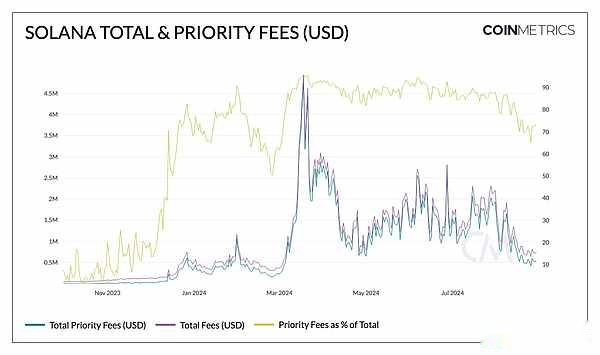
Source: Coin Metrics Network Data Pro
Promoted by the overall market and Memecoin, the total cost of Solana reached a peak of $ 4.5 million in March.At this time, the priority cost accounts for 95% of the total cost (this number has remained at about 80% since August), which represents the high demand for transactions.However, the activity has been significantly reduced, with a total cost of $ 732,000 and a priority cost of $ 533,000.
Use and use characteristics
The typical use mode of blockchain on the first floor may be different. Some blockchain needles optimize large -scale and small transactions, while some blockchains are good at handling large transactions.Therefore, it is important to comprehensively consider the “economic throughput” of these systems, instead of just considering the simple transaction quantity.
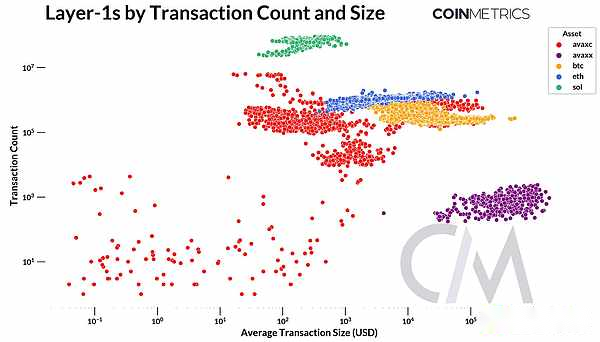
Source: Coin Metrics Network Data Pro, Nic Carter: The number of transactions is a poor measure of measurement
As shown above, low -cost networks like Solana have been optimized and are mainly used for high -frequency and low -value transactions.It is worth noting that Solana also contains the verified voting transaction in the block (deleted from this figure to represent users’ transactions).Bitcoin usually has high value transfer, which is consistent with the role of the value storage and settlement layer, while Ethereum is between high -value transfer and more frequent and lower value transactions, reflecting it as a general blockThe nature of the chain.Avalanche’s variant indicates that the network can adapt to different use cases due to its multi -chain architecture.
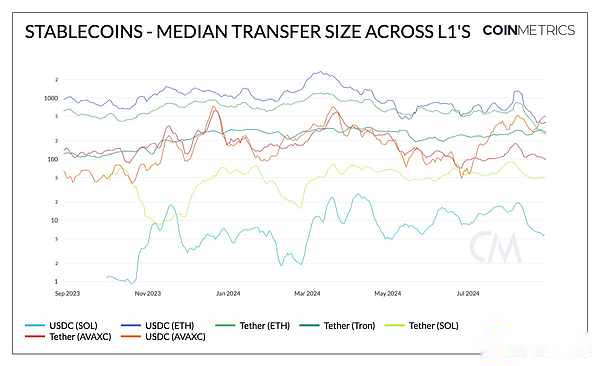 Source: Coin Metrics Network Data Pro
Source: Coin Metrics Network Data Pro
This trend is also reflected in the figure above, which shows the median transfer scale of each major stablecoin (USDC and USDT) on the first layer.The USDC and USDT on Ethereum usually show a higher medium -level transfer scale -although it has recently dropped to $ 400 and $ 267, which is due to the reduction in the cost of Ethereum main network.TETHER on TRON has maintained a typical scale of $ 270, while Solana’s stable currency transfer value (USDC is $ 7) and (USDT is $ 50).
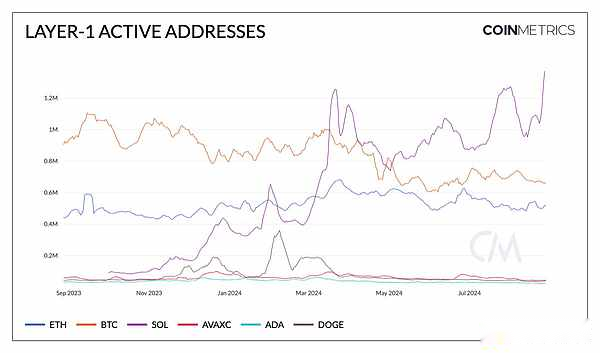 Source: Coin Metrics Network Data Pro
Source: Coin Metrics Network Data Pro
The daily active address on the first floor indicates that the only address that is active in the network every day can be used as an indicator of the blockchain adoption and activity.Bitcoin (672K) and Ethereum L1 (500K) maintained relatively stable active addresses, while Solana’s active wallet since January 2024 increased by about 219%to more than 1.5 million.When explaining this indicator, it is important to consider the differences in the blockchain architecture (UTXO and account -based models), potential inflation caused by robotic activities, and addresses that are not necessarily the same as the only user.
in conclusion
As the basic layer of the ecosystem on the chain, Layer-1 will continue to receive widespread attention.Looking forward to the future, technical improvement and the ability to attract adoption through its applications will shape the future of these networks.Ethereum is about to be launchedPectraUpgrade, and discussions that optimize BLOB price discovery and L1 scalability will enhance its performance and accessability.The Breakpoint meeting of Solana may reveal the key development of further improving its high throughput capacity.At the same time, new entrants like Monad have brought growth opportunities and exacerbated the competitive pattern.
Although each Layer-1 follows its route map, they may be integrated through different balances-balanced scalability, security and decentralization to meet the growing demand for blockchain.


